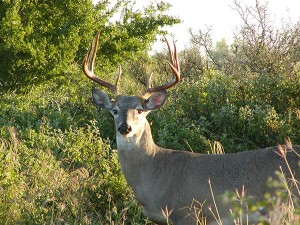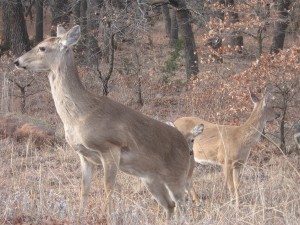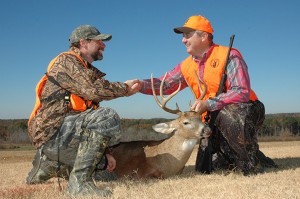Quality Deer Management in Oklahoma
Introduction
The white-tailed deer (hereafter deer) is the most managed and hunted wildlife species in Oklahoma. Deer habitat can be found in all 77 Oklahoma counties. Many land managers are interested in managing deer on their property. Although deer management often focuses on improving habitat, population management is just as important.
Most land in Oklahoma is privately-owned and deer populations are managed within the
constraints of state regulations. This Fact Sheet is intended to provide land managers
with general recommendations and options to meet their specific deer management goals.
Deer Management Approaches
There are three broad deer management strategies: Traditional, Trophy and Quality
Deer Management.
Traditional Deer Management allows harvest of any antlered buck and relatively restricted doe harvest. This approach can lead to high annual buck mortality, high deer density and skewed sex ratios, often favoring many more does than bucks, and few older bucks available for harvest. Because of these issues with Traditional Deer Management, many managers seek alternatives to improve deer habitat, hunter satisfaction, antler size and/or overall herd health.
Trophy Deer Management focuses on allowing many bucks to survive into the 5.5- to 7.5-year-old age classes to achieve maximum antler size. To manage under “trophy” guidelines, deer managers typically need to control several thousand contiguous acres. Trophy Deer Management is not practical for most land managers because of land size requirements, financial constraints and statewide hunting regulations.
An alternative approach, Quality Deer Management (QDM), is well within reach for any land manager. This management style bridges the gap between Traditional and Trophy Deer Management. It was first introduced by Texas wildlife biologists Al Brothers and Murphy Ray, Jr., in their landmark book “Producing Quality Whitetails.” There are four cornerstones to QDM: herd management, habitat management, hunter management and herd monitoring. Although land size is an important consideration under QDM, this style of management seeks to manage deer below the carrying capacity of the land to ensure animals have adequate nutrition and cover. Many small properties can manage under QDM guidelines and work with adjoining landowners to initiate deer management cooperatives (see Quality Deer Management Cooperatives below) to increase the acreage under similar management. QDM seeks to provide high-quality food, cover and adequate water, through various habitat management techniques. Techniques such as prescribed fire, grazing management, discing and forest management may be used as appropriate to improve habitat conditions. QDM also involves adequate doe harvest to keep deer density below carrying capacity, while allowing young bucks to have the opportunity to reach older age classes. Herd monitoring, such as recording harvest data and conducting camera or spotlight surveys, also is an important component of QDM to evaluate effects of management.
Quality Deer Management
Herd Management
One of the most important parts of QDM is herd management. Proper harvest management maintains the deer population within the carrying capacity and allows adequate nutrition for growth and maintenance of the deer herd. By allowing young bucks to progress into the older age classes, hunter excitement and satisfaction are increased because more mature bucks are present to hunt.
Buck Age Structure
Buck age is one of the most important aspect of a deer manager’s plan. Increasing buck age structure is a priority in most QDM programs. The presence of older bucks coupled with adequate harvest of does, (see Antlerless Harvest) improves the social structure of the herd, which may result in a shorter and more intense rut. Larger antlers, of course, are a by-product of an increased buck age structure. For a buck to achieve his potential, he must get old enough to express that potential. Increasing buck age structure is as simple as allowing young bucks (1.5 to 2.5 years old) to escape harvest. Once a buck reaches 4.5 years old, he has expressed 90 percent or more of his antler growth potential.
Many hunters overemphasize genetics rather than focusing on deer age and nutrition. Research has repeatedly shown that hunter harvest cannot control the genetics of a deer herd. In fact, most of the bucks on a given hunting area were not born there. They were born, on average, 2 miles to 5 miles away, prior to dispersing and setting up their permanent home range. Unfortunately, every year, many bucks are ‘culled’ as ‘inferior’ deer, when in fact they simply may be young animals or perhaps injured – factors that are unrelated to antler genetics in any way. Further, multiple bucks are contributing to the annual fawn production, as most bucks only sire a few fawns per year. In addition, at least half of a buck’s genetic potential comes from his mother, which helps illustrate how shooting specific bucks does not significantly influence genetics within a given area.
Figure 1. Mature bucks are a product of passing on young bucks. Photo courtesy of Joe Hamilton.
Buck Harvest Management
1) No buck less than a specified age may be harvested,
2) A hunter may harvest only one buck per season,
3) A hunter must harvest a specified number of does before harvesting a buck, or
4) A hunter must either full-shoulder mount every buck they harvest or be subject to a nominal “fine” if the buck is younger than the age specified in the objectives.
The level of restrictions placed on a property will be based on objectives and the ability of those hunters to follow the harvest guidelines.
Antlerless Harvest
Managing the antlerless segment of a deer herd is important to achieving a more balanced sex ratio and maintaining healthy deer populations. Adequate doe harvest is necessary to control the number of deer on a property. Besides ensuring the population is in balance with the habitat, harvesting does and balancing the sex ratio may intensify the rut in a given area. This can result in increased buck sightings and hunter excitement. In addition, because reduced population size means individual animals will have greater availability of forage, antler size and body weight of deer may increase if the population is at or below carrying capacity. Further, doe harvest is a great way to introduce new hunters to deer hunting.
Figure 2. Doe harvest is an important part of deer management. Photo courtesy of Dwayne Elmore.
Habitat Management
Improving available nutrition via habitat management is another cornerstone of QDM. A deer must obtain 8 percent to 10 percent protein in its diet to maintain body condition. Lactating does may use approximately 20 percent protein, fawns about 22 percent protein, and mature bucks need at least 16 percent protein for maximum growth. Adequate levels of calcium, phosphorous, and other nutrients also are vital to the development of bone and muscle. Knowledge of the plant community (plant composition and structure) is required to provide adequate nutrition and cover, and habitat management is required for proper management. Habitat management for deer on rangelands commonly involves prescribed fire, selective herbicides, prescribed grazing, and discing to improve plant composition and structure. Forests may be improved through regeneration harvests, thinning and prescribed fire, depending on forest conditions and management objectives. Because habitat management is such an integral part of deer herd management, please see the Oklahoma Cooperative Extension Service publication E979- White-tailed Deer Habitat Evaluation and Management Guide.
Figure 3. High-quality deer habitat in central Oklahoma. Photo courtesy of Dwayne Elmore.
Hunter Management
Education is the key to increase knowledge of QDM to fellow hunters and those on neighboring properties. Hunters must understand the benefits of QDM and abide by sound guidelines to achieve management objectives. Hunters should recognize that their decision on harvest is a management decision that affects the quality of the herd in future years.
In situations where land ownership patterns are relatively small, Quality Deer Management Cooperatives can greatly increase the number of acres under management. A Quality Deer Management Cooperative is a group of property owners and/or lease hunters who work together to improve the quality of the deer herd and hunting experiences on their collective properties. Cooperatives vary in size, number of participants, and organizational structure depending on the needs and objectives of members. By working together, members gain the management advantages of a larger landowner. Cooperatives are voluntary affiliations and do not entitle neighboring hunter’s access to other properties or diminish the landowner’s control. They are simply groups of landowners and hunters that establish and agree to deer management guidelines that will enable improved management over a larger area.
The average home range of adult bucks varies from several hundred to several thousand acres, depending on habitat quality. Most young bucks disperse one to several miles from their birth area between the ages of six and 18 months. Therefore, several thousand acres are required to contain the normal movements of bucks in a given area. Larger areas under management enable a greater percentage of the “neighborhood” deer herd to be effectively managed.
Figure 4. Adjoining landowners can assist each other in reaching deer management goals. Photo courtesy of Quality Deer Management Association.
Herd Monitoring
Herd monitoring is the final cornerstone of QDM. There are two types of data important to collect – harvest data and observation data. Harvest data should be collected from every deer harvested on a property. These harvest data include sex, age (estimated by tooth wear – see qdma.com), weight (either live or dressed weight) and antler measurements (inside spread, circumference measurements, number of points and beam length). Reproductive information collected from females include whether the doe is lactating (if harvested early in the season) or the number and size of fetuses (if harvested during late season). Observation data include recording the number of deer by sex and age seen by hunters during every hunt, camera surveys (see qdma.com) and spotlight surveys. Monitoring plant communities and food plots through browse surveys or exclusion cages is a helpful way to make better deer harvest decisions relative to herd density goals. For assistance with conducting browse or other vegetation surveys, contact your local OSU Extension, USDA-NRCS, or Oklahoma Department of Wildlife Conservation (ODWC) office.
Programs Offered in Oklahoma
The Deer Management Assistance Program (DMAP) is a cooperative program developed by ODWC to help land managers reach their herd management goals. A minimum of 1,000 acres of land is required to participate in DMAP. However, landowners can pool their land to meet the 1,000 acre requirement. A annual enrollment fee of $200 for properties 4,999 acres or less and $400 for properties with more than 5,000 acres is payable to ODWC for participation in DMAP.
Within this program, the cooperator collects data from the property via spotlight surveys, August 15th to September 15th. The cooperators return the data to the ODWC biologist who then tailors a harvest strategy to help achieve the goals for the property. ODWC also provides a scale, shears, jaw puller, hoist and a record book. Weights of all deer harvested from the property are recorded in the record book, along with the number of points for bucks. A jaw is removed from each animal to estimate age the deer. At the end of the season, the record book and jaws are returned to the biologist. ODWC then provides a report on the number of bucks and does harvested and age-specific data for each sex.
Within DMAP, bucks are harvested following standard archery and firearms season regulations. However, antlerless harvest is allowed for the entire month of December to allow managers to effectively manage doe numbers and achieve deer population goals.
This program works best for a manager or group willing to put in the effort to collect the data and follow the recommendations of the biologist to achieve their goals. Visit the ODWC website at wildlife department.com for more information.
Summary
QDM is an active management strategy enabling land managers and hunters to guide the direction of the deer herd, which differentiates it from Traditional Management. QDM is a more realistic management approach for the average land manager than Trophy Deer Management, which demands much larger acreage. Adequate doe harvest and passing young bucks to develop a balanced sex ratio and age structure are important elements of a successful QDM program. Habitat management is equally important and requires knowledge of plant identification and how to manipulate plant succession. Many resources are available to assist land managers with deer management objectives. The success of a QDM program often depends on landowner cooperation, which takes dedication and communication. Further, proper herd monitoring will be necessary to ensure the herd, habitat and hunters are meeting the objectives. Regardless of the management style you choose, remember to enjoy the resource and be a responsible land steward for all wildlife.




